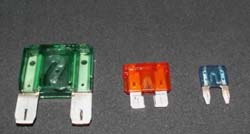A fuse in any circuit is a must have. It’s job is to protect not only the consumer unit in a power surge, (the thing you’re wiring up), but also the cable that connects it.
As with most things in life, you’ll rarely get an exact match of fuse to the current you need to supply, and you’ll find that different styles of fuse offer vastly different available amp ranges. For example, you can get a 1amp glass fuse, but not a 1amp standard blade fuse. The lowest standard blade fuse has a 3A rating. So it’s worth considering all the circuits you need to make before selecting your style of fuse. Never fit a fuse that is rated higher than the cable.
So for example, a single 21watt lamp pulls 1.75amps and I’ve used 5.75amp rated cable -so what fuse do I need? Well a 1amp fuse is out of the question. It needs to be bigger than 1.75A, (the ampage of the bulb), but less than 5.75A, (the ampage of the cable).
Fuses won’t blow precisely at their specified rating. They’ll sometimes survive to double the rating. The fuse rating refers to the amount of amps that it can handle continuously. So with that in mind I’d choose a 2.5a or 3a fuse, (depending on the style), to protect my circuit.
-Tbone



glass fuses